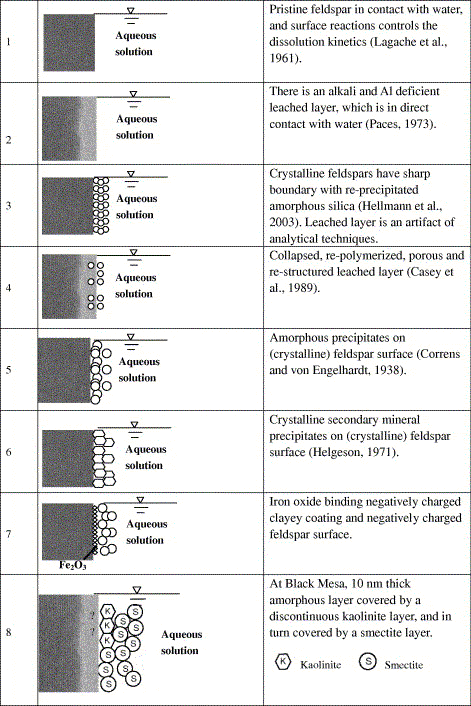Zhu et al.(2006)による〔『Naturally weathered
feldspar surfaces in the Navajo Sandstone aquifer, Black Mesa,
Arizona: Electron microscopic characterization』(4600p)から〕
『アリゾナ州ブラックメサのナバジョ砂岩帯水層における自然風化長石の表面:電子顕微鏡による特性づけ』
『Abstract
Naturally weathered feldspar surfaces in the Jurassic Navajo
Sandstone at Black Mesa, Arizona, was characterized with high-resolution
transmission and analytical electron microscope (HRTEM-AEM) and
field emission gun scanning electron microscope (FEG-SEM). Here,
we report the fist HRTEM observation of a 10-nm thick amorphous
layer on naturally weathered K-feldspar in currently sightly alkaline
groundwater. The amorphous layer is probably deficient in K and
enriched in Si. In addition to the amorphous layer, the feldspar
surfaces are also partially coated with tightly adhered kaolin
platelets. Outside of the kaolin coatings, feldspar grains are
covered with a continuous 3-5μm thick layer of authigenic smectite,
which also coats quartz and other sediment grains. Authigenic
K-feldspar overgrowth and etch pits were also found on feldspar
grains. These characteristics of the aged feldspar surfaces accentuate
in the differences in reactivity between the freshly ground feldspar
powders used in laboratory experiments and feldspar grains in
natural systems, and may partially contribute to the commonly
observed apparent laboratory-field dissolution rate discrepancy.
At Black Mesa, feldspars in the Navajo Sandstone are dissolving
at 〜105 times slower than laboratory rate at comparable
temperature and pH under far from equilibrium condition. The tightly
adhered kaolin platelets reduce the feldspar reactive surface
area, and the authigenic K-feldspar overgrowth reduces the feldspar
reactivity. However, the continuous smectite coating layer does
not appear to constitute a diffusion barrier. The exact role of
the amorphous layer on feldspar dissolution kinetics depends on
the origin of the layer (leached layer versus re-precipitated
silica), which is uncertain at present. However, the nanometer
thin layer can be detected only with HRTEM, and thus our study
raises the possibility of its wide occurrence in geological systems.
Rate laws and proposed mechanisms should consider the possibility
of this amorphous layer on feldspar surface.』
1. Introduction
2. Geology, hydrology, and geochemistry settings
3. Sampling and experimental methods
3.1. Sampling and size fractionation
3.2. X-ray diffraction
3.3. Electron microscopy and electron microscope analysis
4. Results and discussion
4.1. Mineralogical compositions of Navajo Sandstone at Black
Mesa
4.2. Clay coatings
4.3. Surface morphology of feldspar grains
4.4. Possible implications of coatings on feldspar dissolution
kinetics
4.5. Amorphous surface layer
4.5.1. HRTEM observations
4.5.2. Comparison with previous studies
4.5.3. Postulation of the origin of amorphous layer at Black
Mesa
4.6. Paragenesis, surface features, and coating minerals
5. Conclusions and remarks
Acknowledgments
References

Fig. 1. Various hypotheses of the feldspar-water interfaces.
〔Zhu,C., Veblen,D.R., Blum,A.E. and Chipera,S.J.(2006): Naturally
weathered feldspar surfaces in the Navajo Sandstone aquifer,
Black Mesa, Arizona: Electron microscopic characterization.
Geochimica et Cosmochimica Acta, 70, 4600-4616.から〕 |
戻る
